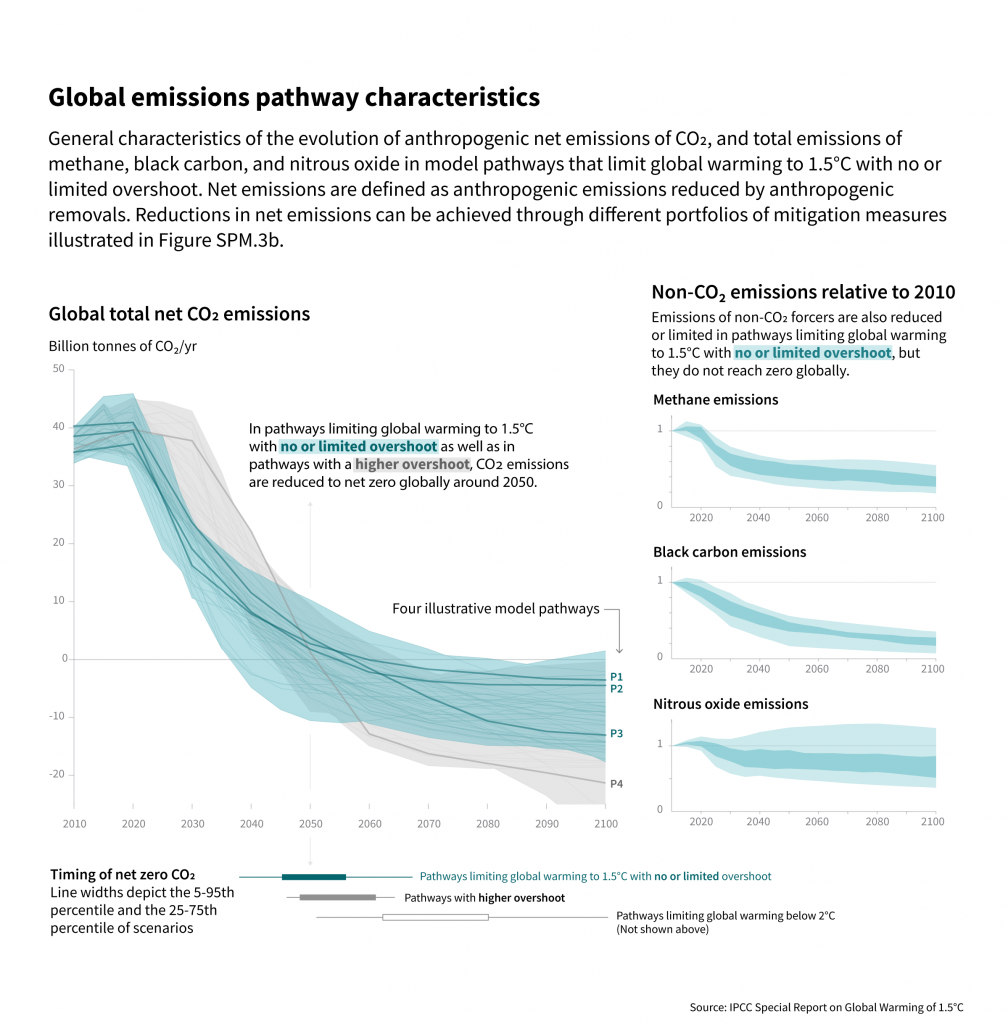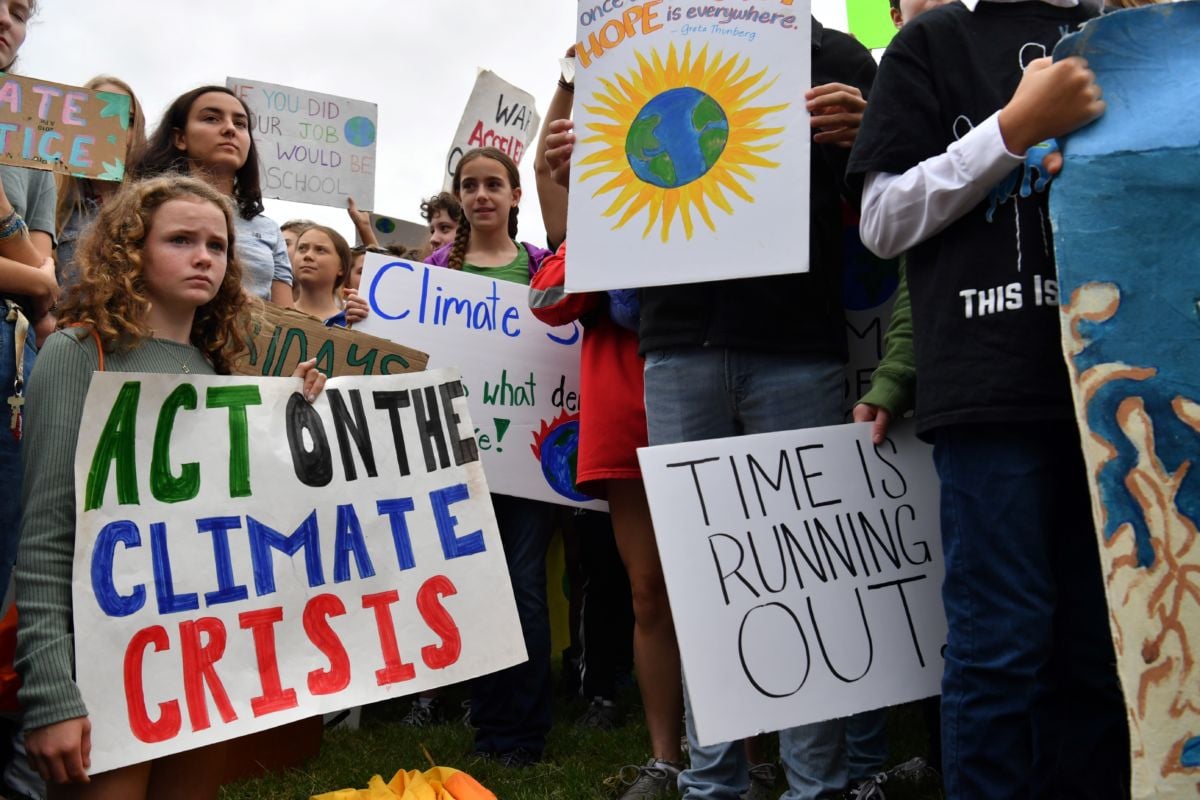Part of the Series
Covering Climate Now
Net zero greenhouse gas emissions by 2050 has become the rallying call behind the UN Climate Action Summit starting on September 23. In letters sent to all heads of state, UN Secretary-General António Guterres called on all countries to develop plans on how they aim to achieve that target: “all leaders [should] come to the Summit ready to announce the plans that they will set next year to reduce greenhouse gas emissions for 2030 and to achieve net zero emissions by 2050.”
On the surface, Guterres’s call to action aligns with the 2018 Intergovernmental Panel on Climate Change (IPCC) report finding that to keep global warming from crossing the vital threshold of 1.5°C, we will need to reach net zero by 2050. However, the devil is in the details, for how we plan now to achieve net zero will determine whether we really hit 1.5°C or take a huge gamble with the future of the planet.
Unreliable, Uncertain and Risky Technology
Economists use Integrated Assessment Models (IAMs) to model pathways to 1.5°C. As the IPCC graph below shows, many of those IAMs rely on first emitting much more carbon than is compatible with 1.5°C — what’s called “overshooting.” After overshooting, many of those models then assume that we can pull massive amounts of carbon out of the atmosphere.

Relying on carbon-sucking technologies might sound like a smart plan to buy us time for the renewable energy transition. However, the glaring problem is that many of those technologies are largely speculative, unproven or deeply expensive and resource intensive.
Last year, Nature Communications published a comprehensive study evaluating a range of negative-emissions technologies. Their study concluded that “all are in early stages of development, involve substantial uncertainties and risks, and raise ethical and governance dilemmas.”
The study finds that there is no certainty that any of the negative technologies could ever scale and concludes that “based on present knowledge, climate geoengineering techniques cannot be relied on to significantly contribute to meeting the Paris Agreement temperature goals.”
There are some “natural climate solutions,” such as conservation, reforestation and improving soil health, which sequester carbon and have positive ecological benefits. However, their potential scale is limited, such that many of the overshoot scenarios assume dependence on uncertain technologies for achieving net zero.
While there might be technological advances which unlock negative emissions technologies, to gamble on them is to gamble on the future of our planet. As moral philosopher Henry Shue argues, betting on negative emission technologies rather than reducing emissions now is a completely unjustified, morally compromised form of “climate dreaming.” “‘Buying time’ on mitigation is a scientifically naive fantasy. No [negative emission technology] is a ‘get-out-of-jail-free card’.”
Big Oil’s Net Zero
It should be no surprise that the fossil fuel industry wants us to be engaged in morally compromised “climate dreaming.” Oil giant Shell’s vision of a Paris agreement-compliant pathway (which it is not even following) relies on just such a vision: continue burning fossil fuels for decades to come and hope we can magically pull those emissions out of the atmosphere later.
We’ve seen this story before, with carbon capture and storage (CCS) technologies. For decades, the fossil fuel industry promised it would be able to capture and store carbon emissions from power plants. Billions of dollars’ worth of research and fancy PR later, CCS remains a pipe dream too expensive and resource intensive to implement.
The U.S.’s flagship “clean coal” power plant, equipped with carbon capture and storage, was declared dead on arrival by its chief executive, as the plant simply cannot turn a profit burning coal. This follows a global trend, where hopes of CCS are crashing on the rocks of economic reality, especially as renewable energy’s prices continue to plummet.
With CCS languishing in the face of economic headwinds, studies show CCS is developing at a rate 100 times slower than what would be needed for it to play a meaningful role in mitigation efforts. Yet now we are being promised even more elaborate negative emissions technologies which will pull carbon out of the air in the future, giving fossil fuel companies free rein to pollute more now.
A Better Net Zero
Fortunately, not all pathways that get us to 1.5°C rely on such problematic negative emissions technologies. Several models show how we can meet that target while not overshooting 1.5°C, or doing so in very limited ways.
For example, one study shows we can achieve 1.5°C while meeting many of the world’s sustainable development goals, including zero hunger, good health and affordable renewable energy for all. We can do so through interventions that are beneficial for overall well-being, such as improving energy efficiency, agricultural practices, switching to healthier diets and reducing deforestation.
Models that get us to meet 1.5°C without relying heavily on negative emissions all rely on us moving rapidly to a clean energy future. Fortunately, stunning advances in clean energy make that a deeply desirable and possible future.
A groundbreaking major study over nearly five years by scientists and economists around the world showed that with technologies currently available, all countries can get to 100 percent renewable energy by 2050 in electricity, heat, transport and desalination, and doing so would cost less than our current energy system and create millions more jobs.
Rather than relying on the promise of uncertain technological advances in negative emissions technologies, we can rely on amazing advances in clean energy which have already occurred. Rather than gambling our children’s future on geoengineering, we can embrace a renewable energy future, which enhances our ability to achieve the world’s sustainable development goals.
Common Undifferentiated Responsibilities?
Adhering to a less risky vision of net zero, Bernie Sanders’s vision of a Green New Deal rejects reliance on “false solutions” like carbon capture and geoengineering, and promises radical action in the next 10 years, not 30 years from now.
Sanders’s vision stands ahead of other presidential candidates by promising action to lower U.S. emissions by 71 percent by 2030. However, Sanders’s long-term goal, like other Democratic presidential candidates, is net zero by 2050, meaning that Sanders’s initial lead in ambition seems to wane in the long-term.
Net zero by 2050 might seem ambitious given the reality of a Trump presidency. However, if the IPCC says the whole world must be net zero by 2050 to meet 1.5°C, then any reasonable theory of climate justice would suggest that the U.S., as the world’s largest historic emitter and richest nation, must go net zero well before.
One of the central principles of the United Nations Framework Convention on Climate Change is that countries have common but differentiated responsibilities to act on climate change. The extent of a nation’s responsibilities depends on factors such as how much they have emitted in the past, how rich they are, and their capability to transition.
Guterres’s blanket call for all countries to reach net zero by 2050 ignores or violates that central principle of justice underpinning our climate regime. So does the seeming consensus among Democratic presidential candidates to hit net zero by 2050.
In the end, the world must aim for net zero. However, in the name of global climate justice, rich, historically polluting countries must get to that point much earlier than 2050 in order to allow developing countries time to catch up.
We also cannot allow just any vision of net zero. The guiding rule must be to reduce emissions as quickly and equitably as possible with reliable, already available methods: winding down fossil fuel use and restoring carbon sequestration, life-giving soils and ecosystems. While negative technologies might emerge, we cannot risk delaying action now in the hope that they will.
This story is part of Covering Climate Now, a global collaboration of more than 220 news outlets to strengthen coverage of the climate story.
24 Hours Left: All gifts to Truthout now matched!
From now until the end of the year, all donations to Truthout will be matched dollar for dollar up to $18,000! Thanks to a generous supporter, your one-time gift today will be matched immediately. As well, your monthly donation will be matched for the whole first year, doubling your impact.
We have just 24 hours left to raise $18,000 and receive the full match.
This matching gift comes at a critical time. As Trump attempts to silence dissenting voices and oppositional nonprofits, reader support is our best defense against the right-wing agenda.
Help Truthout confront Trump’s fascism in 2026, and have your donation matched now!
